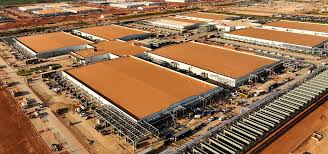The era of low-cost goods that Americans had for roughly 25 years prior to the pandemic may come to an end as a result of President Donald Trump’s proposed tariffs, which threaten to raise the cost of clothing, cell phones, furniture, and many other items in the months ahead.
White House officials anticipate that by driving production back to the US, the import levies will increase the number of high-paying manufacturing jobs.
The implementation of this politically perilous trade-off may take years, and it would need to get past formidable obstacles like the automation of the majority of contemporary manufacturing.
Average U.S. duties are still far higher than they were a few months ago, despite Trump’s U-turn on Wednesday, which temporarily suspended harsh new tariffs on around 60 countries for 90 days.
All imports are now subject to a 10% duty imposed by Trump, while items from China, the third-largest import source for the US, are subject to hefty 145% tariffs.
Additionally, imports of autos, steel, aluminum, and almost half of items from Canada and Mexico are subject to 25% levies.
According to experts, this has caused the average U.S. tariff to rise from less than 3% before Trump’s presidency to about 20% at present, the highest level since at least the 1940s.
iPhones and cars may become more costly.
Such hefty levies, if they continue, would undo decades of globalization that have reduced prices for American consumers.
Prices have also decreased as a result of other factors, such as automation in factories and technical advancement, especially in electronics like TVs.
However, economists claim that imports help control prices in part because labor costs are lower elsewhere and because American businesses are forced to become more efficient due to increasing competition in the U.S. market.
According to Scott Lincicome, a trade expert at the libertarian Cato Institute, “freer trade has helped moderate inflation over the long term.”
“You’re likely to see more expensive stuff if we are entering a more restricted supply side,” Lincicome stated.
Even if automakers absorb part of the impact of the tariffs, Bank of America forecasts that the new charges may hike car costs by an average of $4,500.
Such a rise would come after recent years of steep price increases that have driven the average cost of a new car to an excruciating $48,000.
Retailers are already beginning to increase prices to stay ahead of the duties, according to Aaron Rubin, CEO of ShipHero LLC, a company that offers software to assist merchants in booking shipments and tracking order delivery.
The pricing of millions of products is captured by ShipHero’s data, which represents around 1% of all e-commerce sales in the United States.
In comparison to the week prior to Trump’s announcement of further tariffs, prices for a range of goods increased 3.9% on Sunday and Monday, according to Rubin.
Due to the high concentration of Apple’s supply chain in China, it is generally anticipated that the business will increase the pricing of its popular items, including iPhones, if the tariffs remain in place.
With a possible 29% price increase, the iPhone 16 Pro Max may experience one of the largest sticker shocks.
The main investment office at UBS estimated that this may increase the beginning price from $1,200 to $1,550.
An extended period of low prices:
Inflation consistently exceeded 4% annually until the mid-1990s, when freer trade and globalization started to pick up steam, even after the double-digit inflation of the 1970s was beaten in the early 1980s.
It averaged less than 2.2% between 1995 and 2020.
The benefits were felt by American consumers.
According to government data, the average cost of apparel decreased by 8% between 1995 and 2020, although overall prices increased by 74% during that same period.
The price of furniture remained relatively constant. The average increase in shoe prices was about 10%.
Officials from the Trump administration have occasionally admitted that the tariffs could result in higher pricing.
The administration’s readiness to minimize the appeal of low-cost goods is a dangerous one, especially in light of the 2021–2023 inflation jump that was the biggest in forty years.
Despite low unemployment, the increase in the cost of necessities like groceries, gas, and housing soured many voters’ perceptions of the economy under former President Joe Biden.
About half of Trump’s supporters stated that the high cost of groceries, petrol, and other items was the most significant factor in their decision to vote, according to AP VoteCast, a nationwide survey conducted last November.
Even though it wasn’t the most crucial issue, 43% of Trump supporters still believed it to be significant.
Some buyers claim they are prepared to pay more for products made in the United States.
Alisha Sholtis, a 38-year-old nurse who is now a social media influencer, used to shop extensively on Temu, a fast-fashion e-commerce site based in China.
She would buy inexpensive toys and electronics as well as dresses and polyester tops for $5 to $25. Temu products will now be subject to significant new levies.
However, Sholtis, who resides in Davison, Michigan, claimed she grew weary of the toys that broke quickly and the garments that disintegrated after only one washing. She now shops somewhere else.
She supports Trump’s intention to return some manufacturing to the United States because she believes it will result in higher-quality products. She added that she wouldn’t mind spending more as a result.
“I would purchase fewer, higher-quality items,” she declared.
Will there be jobs again?
Trump’s top economic advisor, Kevin Hassett, admitted on Sunday that the president’s tariffs “may cause some price increases.”
On ABC’s “This Week,” he pointed out that there have been trade-offs associated with globalization: “We got the cheap goods at the grocery store, but then we had fewer jobs.”
According to Commerce Secretary Howard Lutnick, tariffs would compel a change in industry.
When Lutnick appeared on CBS on April 6, he stated, “The army of millions and millions of human beings screwing in little screws to make iPhones and that kind of thing is going to come to America.”
Apple’s ability to manufacture phones in the US is questioned by analysts.
Dan Ives, an analyst at Wedbush Securities, stated that “the concept of making iPhones in the U.S. is a non-starter,” echoing a commonly held opinion in the financial industry that closely monitors Apple’s every move.
Laptops 1000He calculated that if production were moved to the United States, the $1,000 price tag currently associated with an iPhone manufactured in China or India would skyrocket to over $3,000.
Establishing a factory in the United States might take years, according to Shannon Williams, CEO of the Home Furnishings Association, a trade association for furniture.
With the low unemployment rate of 4.2% in the United States, it’s also unclear if there would be enough workers.
The most creative furniture manufacturers in the United States are lowering their labor requirements by utilizing technology.
She stated, “They’re going through it and automating their assembly line completely.”
According to the Footwear Distributors and Retailers of America, China shipped 1.2 billion pairs of shoes to the US last year.
An estimated 80% of American toys and 26% of American clothing were imported from China in 2023, according to one study.
Williams stated that since most businesses now import from other Asian countries like Vietnam or Malaysia, furniture prices probably won’t increase significantly very soon.
However, she acknowledged that “globalization has helped bring down costs.”
“You could purchase a $699 sofa in 1985 and a $699 sofa today for a reason.”

















